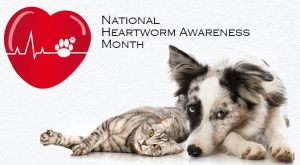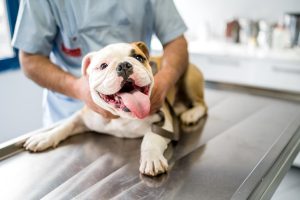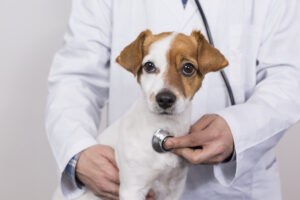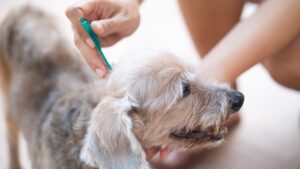Posts Tagged ‘pet immunization’
Celebrating The Responsibility Of Pet Ownership: What It Means to Be a Great Pet Parent
 Responsible Pet Ownership Month is actually in February, but at Olsen Veterinary Clinic, we believe now is the perfect time to reflect on the joy pets bring to our lives—and the responsibilities that come with caring for them. Being a great pet parent goes far beyond providing food and shelter. It means committing to your pet’s health, training, and overall well-being for their entire life.
Responsible Pet Ownership Month is actually in February, but at Olsen Veterinary Clinic, we believe now is the perfect time to reflect on the joy pets bring to our lives—and the responsibilities that come with caring for them. Being a great pet parent goes far beyond providing food and shelter. It means committing to your pet’s health, training, and overall well-being for their entire life.
The Responsibilities of Pet Ownership
1. Prioritizing Healthcare
Routine veterinary care is one of the most important aspects of responsible ownership. Just like people, pets need regular check-ups to stay healthy and catch issues early. Annual wellness exams, vaccinations, parasite prevention, dental care, and senior pet check-ups all play a vital role in ensuring your pet lives a long and happy life. Preventive care not only protects your pet but also helps avoid costly emergencies down the road.
2. Providing Proper Nutrition and Exercise
Feeding your pet a balanced diet appropriate for their age, breed, and health condition is key to maintaining good health. Pairing proper nutrition with regular exercise keeps your pet physically fit and mentally stimulated. Daily walks, playtime, and enrichment activities can help prevent obesity and reduce behavioral issues.
3. Training and Socialization
Good behavior doesn’t happen overnight. Training and socialization are essential for your pet’s safety and happiness. Teaching basic commands, house manners, and positive behavior builds trust and strengthens your bond. Socializing your pet with other animals and people helps prevent fear, anxiety, and aggression, making them a well-adjusted member of the family.
4. Providing Love and Companionship
Pets thrive on love, attention, and companionship. They depend on us not just for their physical needs but also for emotional well-being. Spending quality time together through play, snuggles, or quiet companionship enriches both their life and yours.
5. Commitment for a Lifetime
Welcoming a pet into your home is a lifelong promise. Whether it’s a puppy, kitten, or senior rescue, being a responsible pet parent means committing to their care through all stages of life. This includes adjusting to their changing needs as they age.
The Reward of Responsibility
Responsible pet ownership requires dedication, but the rewards are immeasurable. In return for your care and commitment, pets offer unconditional love, loyalty, and companionship. At Olsen Veterinary Clinic, we are here to support you every step of the way with preventive care, health guidance, and resources to help you be the best pet parent you can be.
Take a moment to reflect on your role as a pet parent and celebrate the bond you share with your furry family members. Together, let’s continue building a world where every pet is healthy, happy, and loved.
April is National Heartworm Awareness Month: What Pet Owners Need to Know
 At Olsen Veterinary Clinic, we believe that knowledge is the first step in protecting your pets. That’s why we’re highlighting National Heartworm Awareness Month this April — a crucial time to educate pet owners on how to prevent and treat this potentially deadly disease in dogs and cats.
At Olsen Veterinary Clinic, we believe that knowledge is the first step in protecting your pets. That’s why we’re highlighting National Heartworm Awareness Month this April — a crucial time to educate pet owners on how to prevent and treat this potentially deadly disease in dogs and cats.
What is Heartworm Disease?
Heartworm disease is a serious and sometimes fatal condition caused by parasitic worms (Dirofilaria immitis) that live in the heart, lungs, and associated blood vessels of affected pets. It is spread through the bite of an infected mosquito and can lead to severe lung disease, heart failure, and damage to other organs.
Dogs and Heartworms
Dogs are natural hosts for heartworms, which means the parasites can live, mature, and reproduce inside them. An untreated infection can lead to permanent damage to the heart and lungs.
Symptoms in dogs may include:
-
Persistent cough
-
Fatigue after moderate activity
-
Decreased appetite
-
Weight loss
-
Swollen belly from fluid buildup
-
In severe cases, sudden collapse or death
Cats and Heartworms
Cats are atypical hosts, so heartworms don’t usually survive to the adult stage. However, even immature worms can cause significant respiratory issues and sudden death. Unlike in dogs, heartworm disease in cats is more difficult to detect and diagnose.
Symptoms in cats may include:
-
Coughing or asthma-like attacks
-
Vomiting
-
Loss of appetite
-
Weight loss
-
Difficulty walking
-
Fainting or seizures
-
Sudden collapse or death
Prevention is the Best Medicine
Heartworm prevention is simple, safe, and cost-effective, especially when compared to the stress and cost of treating an active infection.
Prevention options include:
-
Monthly oral or topical medications
-
Injectable preventatives for dogs that last up to 6–12 months
-
Consistent testing to ensure your pet remains heartworm-free
At Olsen Veterinary Clinic, we can recommend the best prevention program tailored to your pet’s lifestyle and needs. Even indoor pets are at risk, as mosquitoes can enter your home.
Diagnosing and Treating Heartworm Disease
For dogs, a simple blood test can detect heartworm infection. If a dog tests positive, treatment involves a strict and carefully monitored protocol:
-
Stabilization of the pet’s condition
-
Administration of medications to kill adult worms and larvae
-
Strict rest during treatment to reduce risk of complications
For cats, diagnosis is more complex and may involve blood tests, X-rays, or ultrasounds. Unfortunately, there is no approved treatment for heartworm in cats. Supportive care can help manage symptoms, but prevention is absolutely essential.
Protect Your Pet Today
Heartworm disease is a year-round threat, and April serves as a great reminder to stay proactive. Whether you need to start a prevention plan, schedule a heartworm test, or just want to learn more, the team at Olsen Veterinary Clinic is here to help.
Contact us today to schedule your pet’s heartworm screening or to discuss prevention options!
Your pet depends on you for protection — and we’re here to make sure you both have a happy, heartworm-free life.
Understanding Pet Vaccinations: Ensuring Your Pet’s Health
 As pet owners, we all want our furry companions to live long, healthy, and happy lives. One of the most crucial aspects of maintaining your pet’s health is ensuring they receive the appropriate vaccinations. At Olsen Veterinary Clinic, we believe in educating pet owners about the importance of vaccinations, the recommended vaccination schedule, and how these preventive measures contribute to your pet’s overall well-being.
As pet owners, we all want our furry companions to live long, healthy, and happy lives. One of the most crucial aspects of maintaining your pet’s health is ensuring they receive the appropriate vaccinations. At Olsen Veterinary Clinic, we believe in educating pet owners about the importance of vaccinations, the recommended vaccination schedule, and how these preventive measures contribute to your pet’s overall well-being.
Why Are Pet Vaccinations Important?
Vaccinations are vital for protecting pets from various infectious diseases, some of which can be life-threatening. These vaccines work by stimulating the immune system to recognize and fight specific pathogens, such as viruses and bacteria, if your pet is exposed to them in the future. Here are some key reasons why vaccinations are essential:
1. Disease Prevention
Vaccines help prevent numerous diseases that can affect pets. For example, canine parvovirus, distemper, and rabies in dogs, and feline leukemia virus and panleukopenia in cats, are all preventable through vaccination.
2. Public Health
Some diseases that affect pets, like rabies, can be transmitted to humans. By vaccinating your pet, you are also protecting yourself, your family, and your community from potential zoonotic diseases.
3. Legal Requirements
In many areas, certain vaccinations, such as rabies, are required by law. Ensuring your pet is up-to-date with their vaccines helps you stay compliant with local regulations.
4. Cost-Effective Health Care
Preventing diseases through vaccination is often far less expensive than treating the diseases once they occur. Regular vaccinations can save you from costly treatments and emergency vet visits.
Recommended Vaccination Schedule
At Olsen Veterinary Clinic, we follow a vaccination schedule that aligns with the guidelines set by veterinary health authorities. Here is a general outline of the recommended vaccination schedule for dogs and cats:
For Puppies and Dogs:
- 6-8 weeks:
- Distemper
- Parvovirus
- Adenovirus (Hepatitis)
- Parainfluenza
- 10-12 weeks:
- Booster for Distemper, Parvovirus, Adenovirus, and Parainfluenza
- Bordetella (Kennel Cough)
- 14-16 weeks:
- Booster for Distemper, Parvovirus, Adenovirus, and Parainfluenza
- Rabies
- 1 year and annually thereafter:
- Annual boosters for Distemper, Parvovirus, Adenovirus, Parainfluenza, and Rabies
- Optional: Lyme disease, Leptospirosis, and Influenza based on your dog’s risk factors
For Kittens and Cats:
- 6-8 weeks:
- Feline Viral Rhinotracheitis (FVR)
- Calicivirus (FCV)
- Panleukopenia (FPV)
- 10-12 weeks:
- Booster for FVR, FCV, and FPV
- Feline Leukemia Virus (FeLV)
- 14-16 weeks:
- Booster for FVR, FCV, FPV, and FeLV
- Rabies
- 1 year and annually thereafter:
- Annual boosters for FVR, FCV, FPV, FeLV, and Rabies
How Vaccinations Contribute to Your Pet’s Well-Being
Regular vaccinations play a crucial role in maintaining your pet’s overall health and well-being. Here’s how:
1. Boosts Immunity
Vaccines strengthen your pet’s immune system, making them more capable of fighting off infections and reducing the severity of illnesses if they do occur.
2. Reduces Disease Spread
By vaccinating your pets, you are helping to control the spread of contagious diseases within the pet population. This is particularly important in communal settings like parks, boarding facilities, and grooming salons.
3. Improves Quality of Life
Healthy pets are happy pets. Vaccinations protect against debilitating diseases that can significantly reduce your pet’s quality of life, ensuring they stay active and vibrant.
4. Longevity
Preventive care, including regular vaccinations, has been proven to extend the lifespan of pets. By safeguarding them against diseases, you are giving your pet the best chance at a long, healthy life.
At Olsen Veterinary Clinic, we are committed to providing the highest standard of care for your pets. Vaccinations are a cornerstone of preventive health care, and we encourage all pet owners to adhere to the recommended vaccination schedules. By doing so, you are not only protecting your pet but also contributing to the overall health of the animal community.
If you have any questions about your pet’s vaccination needs or would like to schedule an appointment, please contact us at Olsen Veterinary Clinic. Together, we can ensure your pet’s health and happiness for years to come.
The Importance of Regular Veterinary Check-ups
 Regular veterinary check-ups are crucial for maintaining the overall health and well-being of your pets. These routine visits play a key role in preventative care and early detection of health issues. Here are some reasons why regular veterinary check-ups are important.
Regular veterinary check-ups are crucial for maintaining the overall health and well-being of your pets. These routine visits play a key role in preventative care and early detection of health issues. Here are some reasons why regular veterinary check-ups are important.
Preventative Care:
Regular check-ups allow veterinarians to administer vaccinations, parasite control, and dental care. Preventative measure can help protect your pet from various illnesses, ensuring they lead a healthier longer life.
Early Detection of Health Issues:
Pets, like humans, can develop health issues that may not be immediately apparent. Regular check-ups enable veterinarians to detect potential health problems early, often before symptoms become severe. Early detection can significantly improve the prognosis and treatment outcomes.
Disease Screening:
Veterinary check-ups may include screenings and tests for common pet diseases. These screenings can help identify conditions such as diabetes, kidney disease, and certain types of cancer in their early stages, allowing for timely intervention.
Dental Health:
Dental issues are common in pets, and they can lead to various health problems if left untreated. Regular veterinary visits often include dental examinations and cleanings, promoting good oral health and preventing dental diseases.
Nutritional Guidance:
Veterinarians can provide guidance on proper nutrition based on your pet’s age, breed, and health condition. A well-balanced diet is essential for maintaining your pet’s overall health and preventing nutrition-related issues.
Behavioral Assessment:
Veterinarians can assess your pet’s behavior during routine visits. Changes in behavior may be indicative of underlying health issues and addressing them early can prevent further complications.
Weight Management:
Maintaining a healthy weight is crucial for your pet’s well-being. Regular check-ups allow veterinarians to monitor your pet’s weight and provide guidance on nutrition and exercise to prevent obesity-related health issues.
Senior Pet Care:
As pets age, their healthcare needs may change. Regular check-ups become even more critical for senior pets to monitor and address age-related conditions, such as arthritis, dental problems, and organ dysfunction.
Client Education:
Veterinary visits are an opportunity for pet owners to learn about their pet’s specific needs, behaviors, and potential health risks. Education from veterinarians empowers pet owners to provide the best care possible.
In summary, regular veterinary check-ups are essential for preventative care, early detection of health issues, and ensuring that your pets lead healthy and happy lives. Establishing a consistent schedule of veterinary visits can contribute significantly to the overall well-being of your beloved companions. Contact our office today to schedule yours or if you have any questions.
How to Choose the Right Flea and Tick Medicine for Your Dog
 With the weather being nice, people and pets are tired about being cooped up inside. They are starting to enjoy the fresh air, the calm breezes in their face and the warmth of the sun. But whether it is a walk in the park, a weekend camping along the lake or even lounging around your front yard, fleas and ticks could be waiting to latch onto your pet and hitch a ride. So because of this, application of a flea and tick control or collar is essential to prevent them from infesting your home.
With the weather being nice, people and pets are tired about being cooped up inside. They are starting to enjoy the fresh air, the calm breezes in their face and the warmth of the sun. But whether it is a walk in the park, a weekend camping along the lake or even lounging around your front yard, fleas and ticks could be waiting to latch onto your pet and hitch a ride. So because of this, application of a flea and tick control or collar is essential to prevent them from infesting your home.
There are many factors to consider when choosing the optimal product. One must decide if they want a collar, topical or chewable tablet. Each one has their pro’s and con’s about them. The collars and topical products such as Frontline or Advantage have been around a lot longer and may be less expensive to buy, but we have seen breaks in protection because the fleas and ticks have gained resistance or the product has not been used properly. Some of those products are approved by the EPA so they might not be safe to use on your pet. Recently new products such as Nexguard or Bravecto have been developed that are taken orally. Because they are newer products, the fleas and ticks have not developed a resistance to them. Also since they are ingested, they are approved by the FDA to assure their safety to the pet.
There are several oral products available like Simperica Trio that will also control other parasites, along with fleas and ticks. So they may be more expensive but be more convenient in the long run.
The best thing to do is to have a conversation with your vet about what is best for your pet, as well as what works for you financially. We are happy to have a conversation about any concerns you have. Prevention is key, so make sure to protect your furry companion this summer. Contact our offices today!
Cat Safety Tips: How to Protect Your Furry Companion
 Many of us have those 4-legged feline friends that love to hunt and no amount of domestication has changed their inherent desire to patrol their domain in the hunt for prey. We have all seen the look of pure joy on our cat’s faces when they watch birds and small rodents from the window. And because cats are naturally curious, they love to explore. That is why some people allow their cats to spend considerable time outdoors. The downside it that the outdoors has many dangers that can linger and it is our job as responsible owners to keep them safe.
Many of us have those 4-legged feline friends that love to hunt and no amount of domestication has changed their inherent desire to patrol their domain in the hunt for prey. We have all seen the look of pure joy on our cat’s faces when they watch birds and small rodents from the window. And because cats are naturally curious, they love to explore. That is why some people allow their cats to spend considerable time outdoors. The downside it that the outdoors has many dangers that can linger and it is our job as responsible owners to keep them safe.
While most experts would recommend that the best thing to do would be keeping them indoors, you can allow them to get some fresh air in a relative safe environment away from predators that would prey on your cat and making sure that they are protected when they go outside.
Some owners may try to leash train their cat. This is one of the easiest means of monitoring where your cat goes because you get to go along for the walk. Cat’s generally dislike harnesses, so they will need to be made accustom to using them first. This may entail having the harness on inside and provide positive reinforcement with treats. Supervised outdoor time is a great way to bond with your cat and give her the mental stimulation that her wild instincts crave.
Whether you allow her to roam free or keep her as close as possible, it is important for the cat to either have a microchip or some other form of identification on your pet. If you use a collar, a safety collar with an elastic panel will allow your pet to break free if it gets caught.
To allow cats to have the ability to go outside, some owners make a catio that keep predators out and their pet in. This can serve as an outdoor playground within the vicinity of your home. You can feel safe knowing where it is and that she is not running out into the street or being picked up by predator birds or other mammls.
If your cat goes outdoors, it is at risk to the diseases and parasites that the outdoor feral cats have. So it is important to have your pet’s vaccines updated and kept on flea and tick control.
Your back yard can be dangerous to your pet if you have planted some toxic plants for landscaping. Plants like lillies may look nice in your back yard, but they can be toxic to your pet. It is important to make sure that anything potentially toxic and dangerous be picked up and secured. I would also recommend not having mouse poisons available because not only would the poison be toxic, eating a dead mouse that has succumbed to the poison may be also lethal to the cat.
It is important to have a regular dinner time. That way when the cat’s return for it evening meal, they will be able to be locked up for the evening. This will protect her from the nightly predators and allow her to go on daily patrol the next morning.
For any more questions on cats, or any other furry companion, contact our offices today!
New Puppy Checklist: Everything You Need Before Welcoming Your New Furry Friend into Your Life
 Bringing a new puppy into your home is an exciting time but requires some preparation for your home. Puppies require a lot of attention and care, so this checklist will be beneficial if you are unsure where to start with the basics for your new puppy.
Bringing a new puppy into your home is an exciting time but requires some preparation for your home. Puppies require a lot of attention and care, so this checklist will be beneficial if you are unsure where to start with the basics for your new puppy.
Some companies have created puppy starter kits. For example, this box made by Chewy has a set of toys, treats, and potty-training materials to help you with your new puppy. All top-rated items, new puppy owners are sure to appreciate it. It also makes a great gift. It can be found here.
Beyond toys, treats, and potty-training materials, puppies need food and water bowls. There are a lot of different options, but one that is slightly lifted is easier for your puppy to eat from. If you get one with walls, it is more likely your floor will stay cleaner.
Also necessary is a bed for your pet. An elevated bed is good for keeping your dog lifted and is helpful for teaching different cues. Other more traditional options are great too, especially as your pups are growing quickly.
Some owners choose to crate their puppies, and there are a lot of options but must be replaced as dogs grow. Crates help dogs have a safe place, especially as they adjust to a new space and lifestyle.
Also important for your new puppy is a leash. There are many kinds of leashes, with different uses. It will most likely be trial and error to find what works for you and your puppy, so be prepared for a trial period.
Puppies require hygiene efforts. This includes toothbrushes, toothpaste, nail clippers, brushes, and bathing supplies. Providing exposure to these items while young makes it less scary for adult dogs and easier for their owners.
Lastly, a collar is a great way to express your and your pet’s personality. Be prepared for your new pup with a collar and tag to provide some protection and peace of mind.
The last step for a new puppy is establishing an appointment with your veterinarian to get started on vaccinations and discuss your new dog’s life! Feel free to contact Dr. Olsen of Olsen Veterinary Clinic at 618-656-5868 to set up an appointment or discuss any questions!
Dr. Olsen’s Breed Spotlight: The Tibetan Mastiff

Tibetan Mastiff
The Tibetan Mastiff is a large-size Tibetan dog breed. It has a medium to long double coat and is found in many colors. These can be solid black, black and tan, various shades of red (from pale gold to deep red), and bluish gray. Sometimes, they can have white markings around their neck, chest, and legs.
The term mastiff goes back to when the Europeans first went to Tibet. They used the term to refer to nearly all large dog breeds in the West. Early Western visitors misnamed several of its breeds through this process. For example, the Tibetan terrier is not a terrier, and the Tibetan spaniel is not a spaniel.
In the early 20th century, the Prince of Wales, George, introduced a pair of Tibetan Mastiffs to the United Kingdom, which caused the breed to become prevalent enough in England to be shown at the Crystal Palace show in 1906. Since 1980, the breed has been gaining in popularity worldwide.
The Tibetan Mastiff is a primitive breed and retains the general hardiness that would be required of them to survive in the harsh environment of Tibet, Ladakh, and other high-altitude Himalayan regions. Because of this, they tend to have strong instinctive behavior, including canine pack behaviors. These help the breed survive in harsh environments. It has maintained many of the same biological processes as wolfs and other animals.
The dog has a long, double coat whose length depends ultimately on the climate. Uniquely, the Tibetan Mastiff lacks the unpleasant big-dog smell that affects many other large dog breeds. Their coat can shed dirt and odors on its own. Many of the dogs shed somewhat throughout the year, but there is generally one great molt in late Winter or early Spring.
Tibetan Mastiffs have a life expectancy of around 10-16 years, but this span can vary. Generally, the breed has fewer genetic health problems than many other breeds. However, cases can be found of hypothyroidism, entropion, ectropion, distichiasis, skin problems, etc. As with most large breeds, some will suffer from elbow or hip dysplasia.
Hypothyroidism is common in Tibetan Mastiffs, along with many other large “northern” breeds. They should be tested periodically throughout their lives using a complete thyroid panel. However, because the standard thyroid levels were established using domestic dog breeds, test results must be considered in the context of what is “normal” for the breed, not what is standard for all breeds. Many Tibetan Mastiffs will have “low” thyroid values, but no clinical symptoms. Vets and owners differ on the relative merits of medicating dogs that test “low” but are completely asymptomatic.
The Tibetan Mastiff is sure to be a large lovable friend for any owner. Feel free to contact Dr. Olsen at Olsen Veterinary Clinic with any questions at 618-656-5868.
Dr. Olsen’s Breed Spotlight: The Peterbald Cat

The Peterbald cat is a loyal and affectionate feline, known for being “dog-like”. They are very friendly, playful, energetic, and smart. The Peterbald is a descendent of the Don Sphynx cat, still bearing some of its qualities like its varying amount of fur, dexterous front paws, big ears, and wrinkly skin. The other feline in a Peterbald cat is the Oriental Shorthair cat. The Peterbald still carries its long and lithe body shape and oblong head shape from them. However, unique to a Peterbald is their long front toes with webbing. It allows them to hold and manipulate toys, unlike many other cats.
The Peterbald’s fur varies from a velvety, fuzzy fur to a completely hairless cat. There is even a type that doesn’t even have whiskers or eyebrows, making their skin feel sticky to the touch. Also interesting is that Peterbald’s fur changes throughout their life. This means that if a Peterbald has one of these coats at birth, it can change significantly during their first two years of life, and the hair can be altered, gained, or lost.
The care of Peterbald cats varies based on their coat. If they have a thin fur coat or no hair at all, they require weekly bathing and wipe downs to keep their skin free of harmful oils. Since Peterbald cats can have very thin coats, they need to be kept as inside cats. Moreover, many Peterbald cats can sunburn, have sensitivity to extreme temperatures, and can be easily injured when playing with other cats or children. But given proper care, these cats are relatively low maintenance and have very few associated breed-health issues.
If you are looking to adopt a Peterbald, know that these cats are still somewhat rare, so acquiring one is not an easy feat. Be sure to check with animal shelters, rescue groups, and reputable breeders to see if a Peterbald is needing a forever home. Since they are often not readily available, it can be difficult to find a Peterbald kitten. Important to note is that hairless cats are often sold for higher prices.
If you have any questions, feel free to contact Dr. Olsen at Olsen Veterinary Clinic at 618-656-5868!
Tips For Socializing Your Dog
 Socializing your dog teaches them how to react to the world around them healthily without any unnecessary fear or aggression. It is important to start socialization early, so it becomes their normal behavior. Ideally, it should be between three and 12 weeks of age, but not everyone is with their furry friend at that point in their life. Beyond 18 weeks, socialization gets a lot harder, but it is not impossible.
Socializing your dog teaches them how to react to the world around them healthily without any unnecessary fear or aggression. It is important to start socialization early, so it becomes their normal behavior. Ideally, it should be between three and 12 weeks of age, but not everyone is with their furry friend at that point in their life. Beyond 18 weeks, socialization gets a lot harder, but it is not impossible.
An important first step is to take your dog out on daily walks in public. This allows your dog to be exposed to many different experiences such as cars, other dogs, and strangers. The world becomes less scary after a few trips outside. Keep them on a short leash and take your dog on different routes to expose them to new sights and smells. Typically, new puppies should be exposed to different places, bodies of water, woods, beaches, and common neighborhood objects like street signs, bikes, strollers, skateboards, and benches.
Related, expose your dog to a wide variety of people such as men, women, and children so that they can get acclimated to the idea of people other than its owners. If your dog isn’t exposed to people other than its owners, it could become wary of anyone who isn’t their owner, so it is crucial to diversify whom your dog interacts with. Included in socialization is allowing your dog to meet unfamiliar people in unfamiliar clothes like hoods, jackets, sunglasses, and hats.
If your dog acts scared, stay calm and confident. Don’t push them, but don’t make a big deal out of their scared behavior. Use treats to give your dog a positive association with new people and experiences.
Socializing your dog allows them to enjoy the world around them and new experiences. To help your dog not fear new surroundings and people, start early, and show them all that your area has to offer! If you have any questions, feel free to contact Dr. Olsen at Olsen Veterinary Clinic at 618-656-5868.
